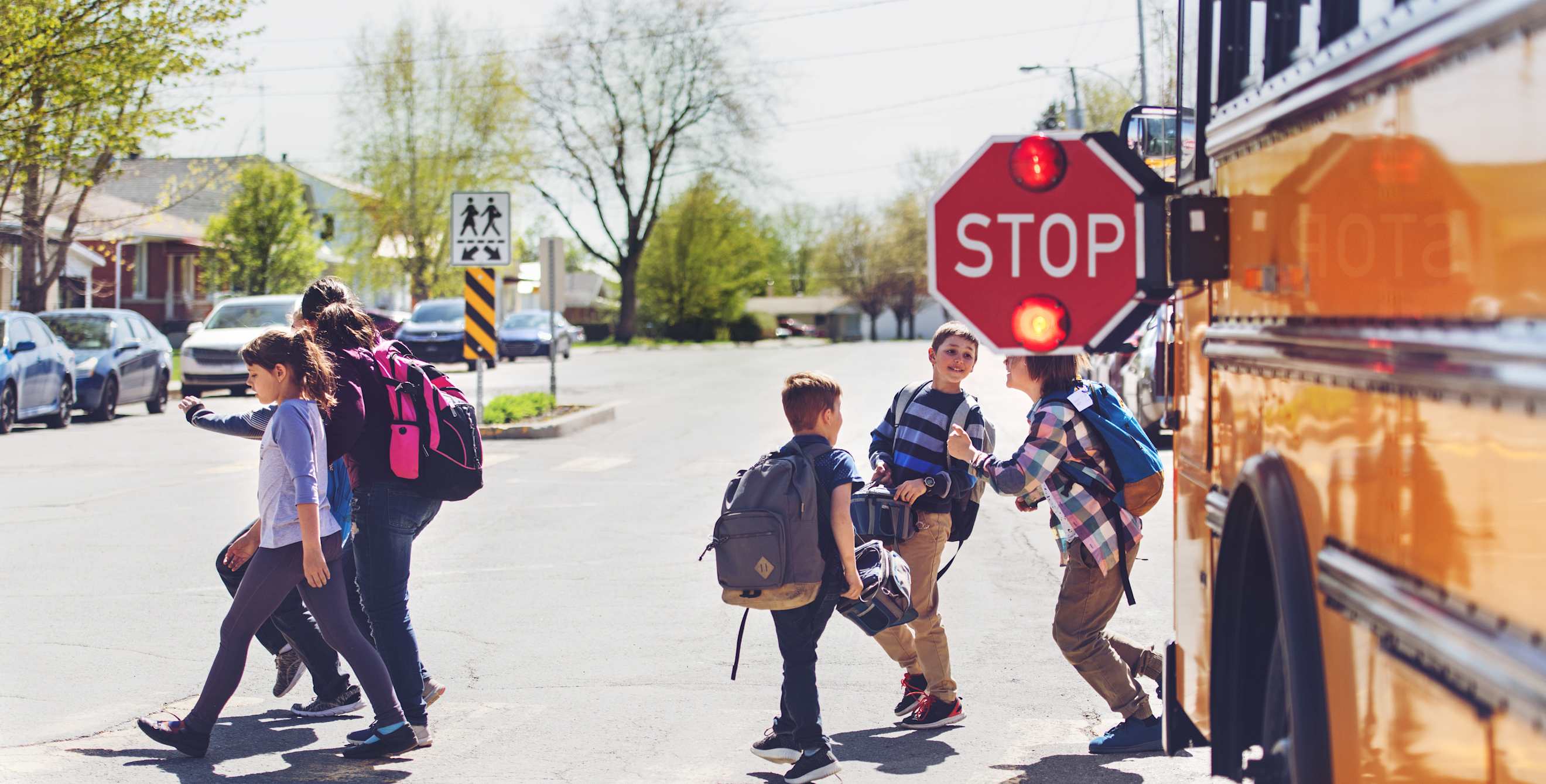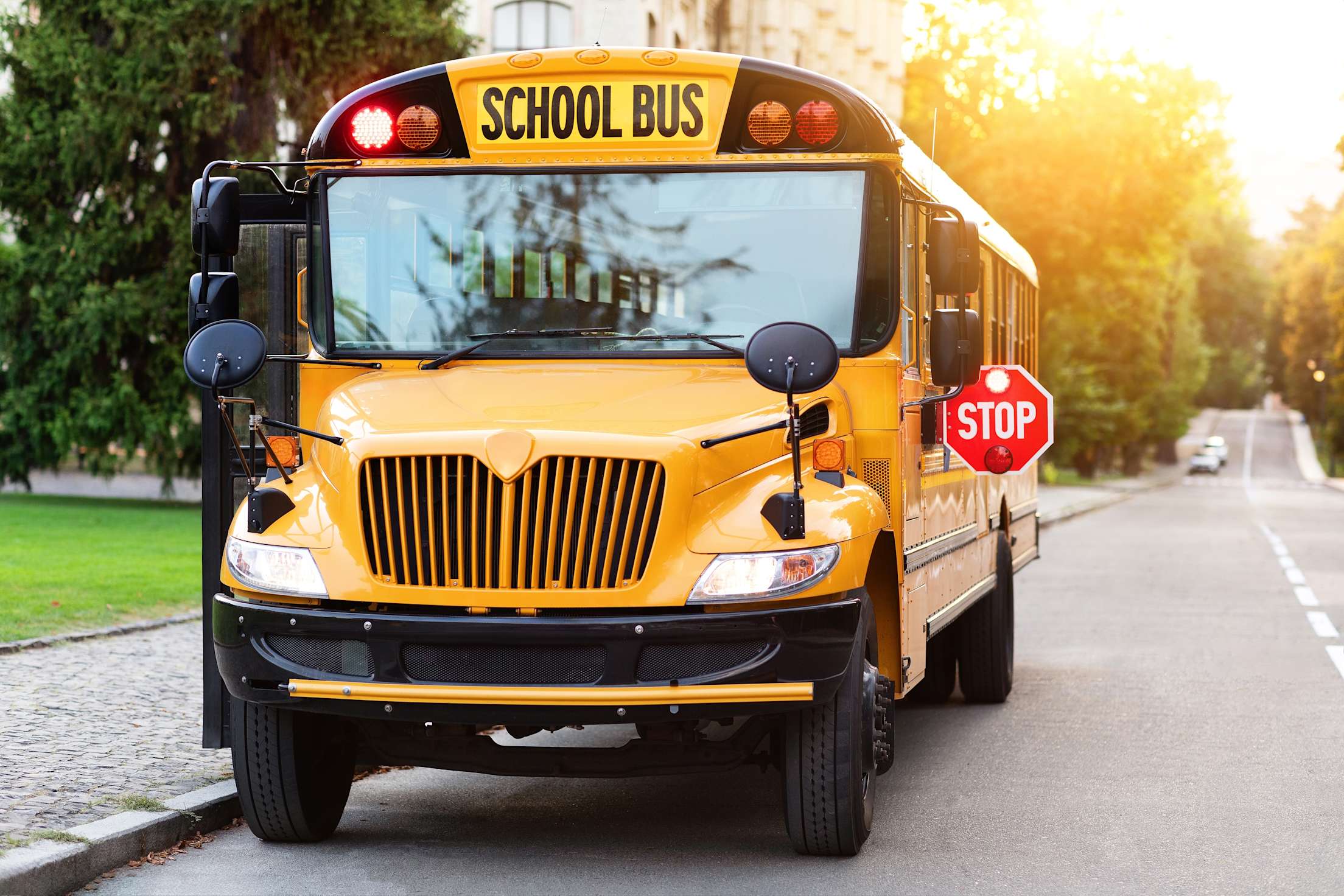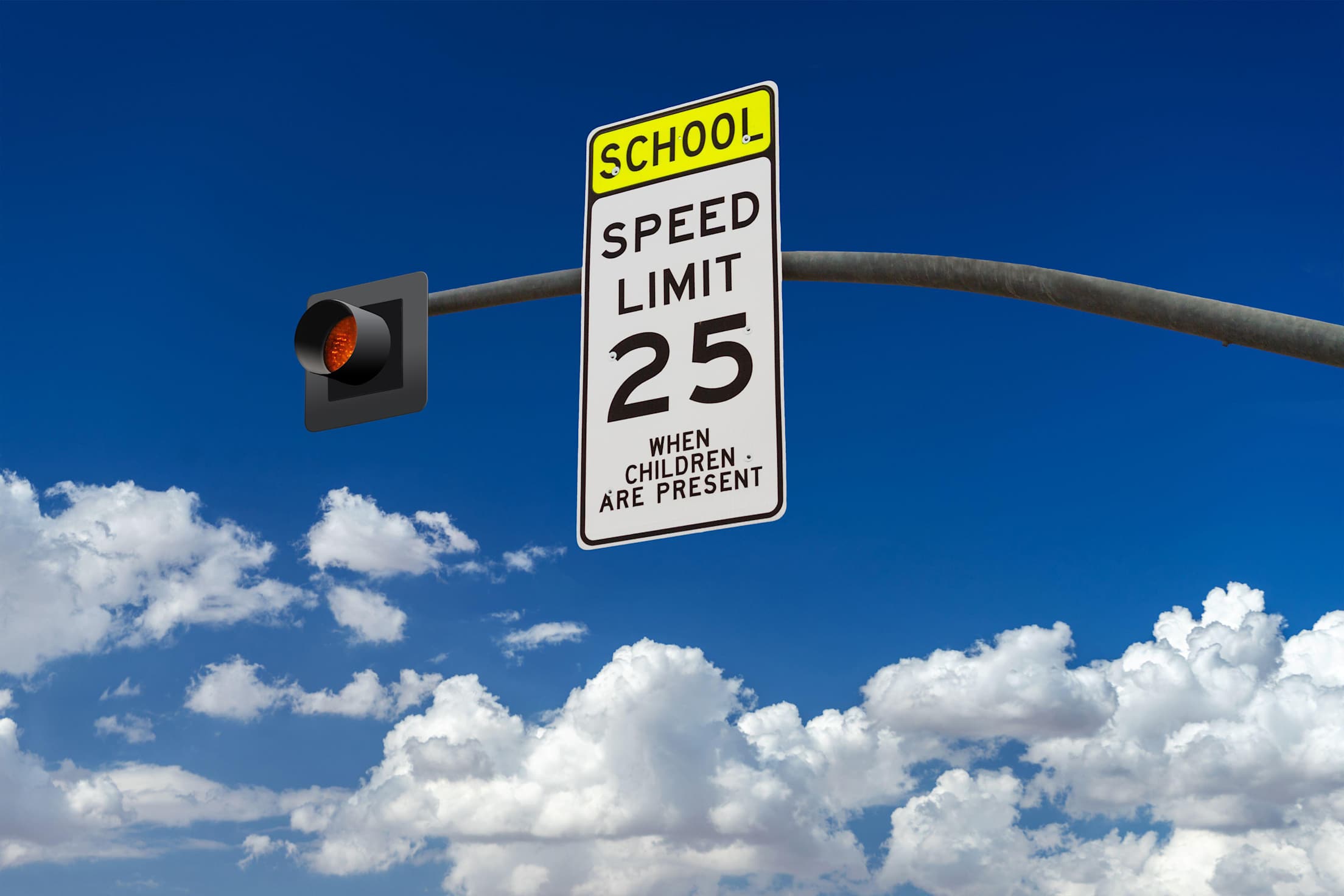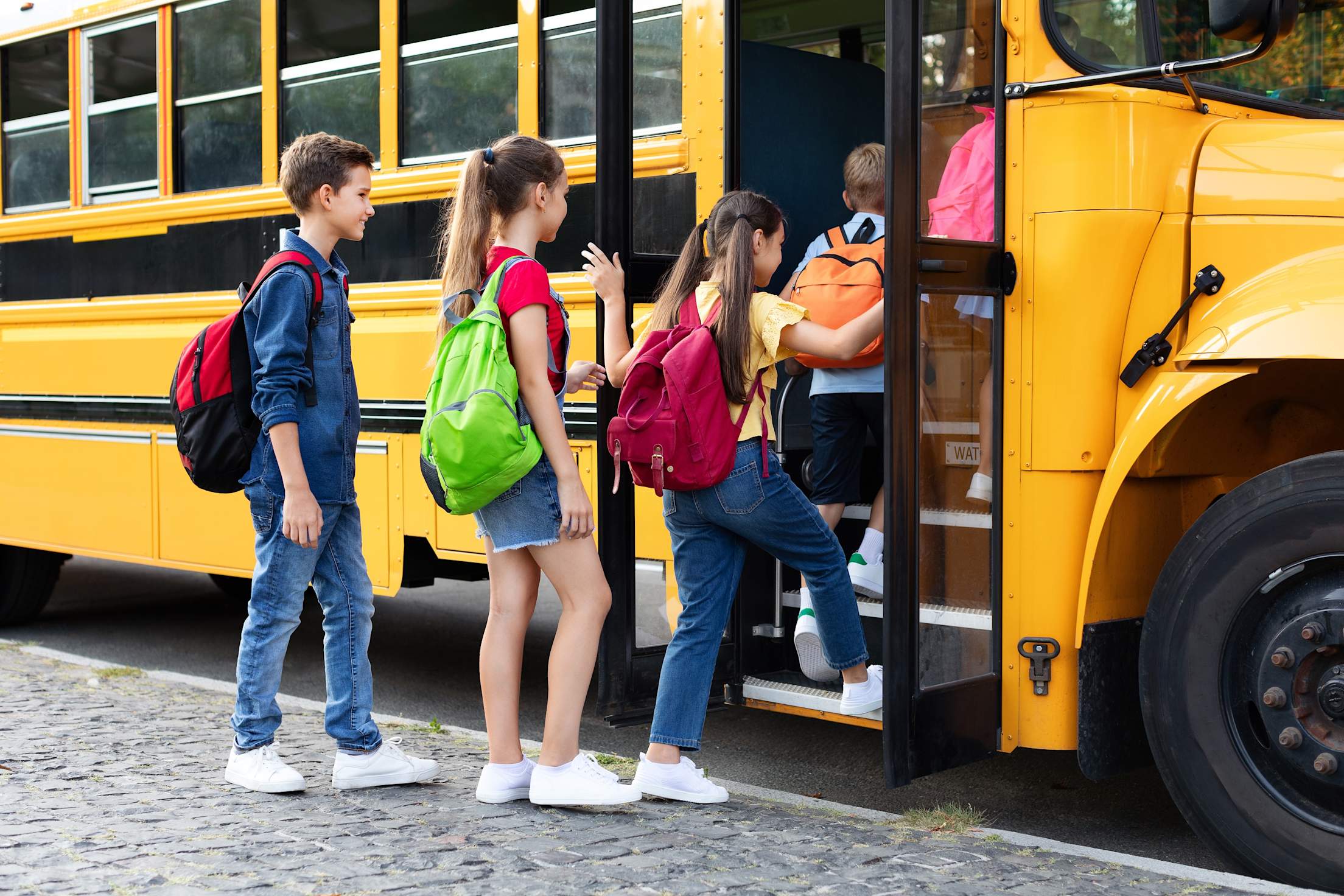
How to Drive Safely Near School Buses
With kids headed back to school, follow these tips to safely share the road.

While it might feel like summer just started, for many parents and kids, it’s already time to start thinking about the return to school. And as the new school year approaches, there’s nothing more important than getting kids to school safely.
A big part of that is staying safe around school buses. Kids who ride the bus, their parents, and other drivers on the road all have a role to play in that mission. Here are some tips to learn—and discuss with kids—before the first day of school.
What Drivers Need to Know
Drivers have a major responsibility when driving near school buses.
“Children on school buses can be very young and not yet aware of the dangers of traffic,” says William Van Tassel, Ph.D., manager of driver training programs at AAA. “So it really falls on us, the drivers.” That responsibility starts with recognizing the signals that school buses use and understanding what they mean.
Know the Signals
- Yellow flashing lights: When you see yellow flashing lights on a school bus, that means the bus is getting ready to stop to board or off-board its young passengers. As a result, when you see them you should slow down your vehicle and get ready to stop as well.
- Red flashing lights and extended stop arms: When you see red flashing lights and extended stop arms on a school bus, it means that the bus has stopped and is actually in the process of loading or unloading children. If you see these signals, you must come to a full stop, then wait until the lights stop flashing, the stop arms retract, and the bus begins to drive away. Only then should you continue to drive.

Know Your State’s Laws
It’s illegal in all states to pass a school bus when the red flashing lights are on and the extended stop arm is out. But your state may also have other laws about driving near buses.
- California: If you’re driving on a two-lane road with no median, drivers on both sides must stop for school buses. This is also the case on two-lane roads with a center turn lane. If there are four lanes with no median, drivers on the opposite side of the bus can continue driving, but should proceed with caution. The same is true if there’s a median breaking up each side of the road. Again, you can only continue when the lights stop flashing and the stop arm is withdrawn.
- Nevada: When the road has a median separating the highway, vehicles on the opposite side of the bus don’t need to stop. But in all other cases, drivers on both sides of the road must come to a complete stop for a bus unloading children.
- Arizona: Drivers in both directions must stop before a school bus when the red lights are flashing and the extended stop arm is out. However, if there’s a divider separating the highway, drivers on the opposite side of the bus may continue and proceed with caution.
“State laws vary, but basically, if the school bus is about to stop or stopped, you don't want to drive by,” says Van Tassel. “Because it's not just children getting off the bus who could be at risk. There might also be children running to the bus to get on from an unexpected area.”
Slow Down in School Zones and Near Bus Stops
School zones have lower speed limits for a reason: It’s important to keep kids safe during pickups and dropoffs and when boarding or exiting a bus. So when you’re in a school zone or near a bus stop, reduce your speed.
Slowing down can ensure you have time to respond to buses coming to a stop, which keeps everyone safe around you, including other drivers. Reducing your speed “can also help notify other drivers who might be distracted and don't see it [the school bus] yet,” says Van Tassel.
Minimize Distractions
Anything that diverts your attention from the road can be a safety hazard. While there may always be some level of distraction to contend with, you can do your part to minimize distractions. When driving, avoid:
- Using your cell phone in any way;
- eating or drinking;
- putting on articles of clothing or makeup; and
- changing the radio station or music playlist.
You always want to keep your hands safely on your steering wheel and stay focused on the road ahead of you—but it becomes even more important when around school buses.
Watch for Children
If you’re near a school bus, be on alert and watch out for children entering or exiting the bus. Children may not always look both ways or may run out into the road, so being extra cautious is paramount.
Be Aware of Blind Spots and Danger Zones
Even if you don’t see children, it doesn’t necessarily mean it’s safe to increase your speed. Especially if you don’t have visibility on all sides of the bus, be aware of blind spots where children can be hiding from view. Additionally, understand the danger zones, where accidents are most likely to happen: up to 30 feet from the front bumper of the bus and 12 feet from the left, right and back sides.
If streets are narrow or there are many parked vehicles, your vision could be blocked. You also want to make sure that you're visible to the drivers of school buses, as well as to children around you.
“Even when school buses are moving, position your car so that the driver of the school bus can see you,” says Van Tassel. “We don't want to be right up behind the school bus, or in one of the blind spots, particularly off the rear corners, because the driver might not see you.”

What Passengers (Kids and Parents) Need to Know
Drivers should take the appropriate steps to be safe around school buses. But kids and their parents can also be proactive about safety. That includes safely boarding and disembarking a school bus. According to the California Department of Motor Vehicles (DMV), more students are killed each year while getting on or off a bus than as passengers on a moving bus.
How to Safely Board
To board safely, students should wait for the school bus in the designated waiting area. While waiting, it's important to face the bus. After the bus comes to a stop, students should only board when the driver says it’s okay to do so. It's safest for children to board single-file and hold onto the handrails for additional safety.
How to Safely Disembark
To safely disembark, students need to wait until the bus comes to a complete stop and the driver says they may exit. Before that, students should be facing forward and in their seats with their seat belts on (if available). When exiting, they should be taught to look to their left, then right, and left again to make sure it’s safe to cross the street.

Other Tips to Improve School Bus Safety
Aside from following boarding and disembarking protocols, passengers can follow these general tips to improve school bus safety:
- Arrive early: When you get to the bus stop early, you can avoid rushing. For both kids and parents, rushing may increase the likelihood of an accident if you’re not aware of your surroundings. Aim to arrive a minimum of five minutes early.
- Avoid playing: While at the bus stop, it’s important for kids to avoid playing. This can be dangerous if they’re near the road. Plus, it can distract them from the bus’s arrival.
- Wait for a complete stop: Before approaching a school bus, let it come to a full stop.
- Use caution: Be careful that clothing or straps don’t get caught in the doors of the bus or on the handrails.
- Know what’s off-limits: Children should be aware of what areas on and around the bus are off-limits; ask your bus driver if you’re unsure where these are. Children should avoid walking behind the bus or directly in front of one.
- Take precautions: If a child needs to cross in front of a school bus, they should do so at least 10 feet from the bus, and only after getting the bus driver’s attention.
- Dress for visibility: Children who wear bright colors are more visible to drivers and others around them.
The Bottom Line
As parents, drivers, and kids adjust to the return to school, everyone must do their part in keeping the roads safe, especially around school buses. As a driver, knowing the signs and signals can help you understand when it’s appropriate to pass and when it’s time to wait. As a parent, you can teach your kids the best practices for being around their bus. Together, everyone can do their part to keep school zones and bus stops safe for all.
Benefit from AAA Membership on and off the road, with emergency assistance, in-branch DMV services, exclusive discounts, and more.